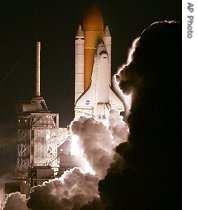-
(单词翻译:双击或拖选)
By David McAlary
Washington
09 December 2006
After a two-day launch delay, the U.S. space shuttle Discovery is back in orbit, heading to a Monday rendezvous1 with the International Space Station. The launch from Florida was the first to take place at night in four years. As VOA's David McAlary reports from Washington, the Discovery astronauts will rewire the growing research outpost for increased power and install a new component2 on its backbone3.
 |
| Space Shuttle Discovery lifts off with a crew of seven at the Kennedy Space Center, Florida |
"There are many activities and many aspects of this flight that probably make it one of the most complex assembly flights that we have done to date," said William Gerstenmaier, NASA's deputy chief for space operations. He said the mission's intricacy can be measured by the number of commands ground controllers will have to make after Discovery docks at the station. "During a typical space station flight, we send about 800 commands a day. On this flight we will send over four-thousand commands over three days."
This shuttle mission is unique because of the need to rewire the space station. Since it went into orbit in 1998, the outpost has been running on a temporary electrical system. But September's shuttle mission brought two new electricity-generating solar arrays to the outpost, so all the pieces are now in place to switch to the permanent system.
Deputy station manager Kirk Shireman said making all the necessary connections will require two astronauts on two spacewalks. "You're basically rewiring your house while you're living in it," he said.
But before any rewiring can be done, the shuttle crew must retract4 half of the solar array that has been providing the temporary power to make room for the new solar wings to rotate. That has never been tried before and could be difficult to retract after a long time in the harsh space environment. It may be like folding a map that has been left out in the weather for years.
Another factor complicating5 Discovery's mission is the requirement to activate6 space station pumps to cool the equipment that converts the solar energy into electricity. The air conditioning system uses ammonia as a coolant, and Shireman says it will be the first time it has operated since being installed four years ago. "We're going to flow ammonia through systems that have not had ammonia in them before. It would be like putting a car in your garage, you keep the battery charged, but, you know, you come back in four years and you turn the key and you hope it starts," he said.
A third spacewalk by Discovery astronauts will install a two-ton segment on the space station's girder-like backbone to serve as a bridge routing power, data, and coolant between other girder segments.
With Discovery's launch, the U.S. space agency has returned to night shuttle liftoffs for the first time since before the 2003 Columbia disaster. The last three missions since the accident have occurred in daylight to give engineers the clearest view of launch. The agency wanted to see whether safety modifications7 to the external fuel tank prevented hard insulating foam8 from breaking off during ascent9 and damaging the orbiter, as happened with Columbia.
NASA believes it has conquered this threat and says it can see almost all it has to now during the fiery10 brilliance11 of engine burn. Shuttle program manager Wayne Hale says that because the shuttle must compete for launch pad time with other types of missions, night operations provide more opportunities to meet the tight schedule of 14 flights needed to complete the space station before the shuttle fleet is retired12 in four years. "If you think about it, it's only light about half the time. It's pretty clear that we would never make the flight rate that's required to assemble the International Space Station," he said.
The seven Discovery crewmembers include Sweden's first astronaut, Christer Fuglesang, who will be one of the spacewalkers. Also aboard is Sunita Williams, an American woman of Indian ancestry13 who will exchange places with one of the three space station crewmen, Thomas Reiter of Germany. It will be the first crew transfer via the shuttle since Russian Soyuz rockets took over the job after the 2003 Columbia accident.
 收听单词发音
收听单词发音
1
rendezvous

|
|
| n.约会,约会地点,汇合点;vi.汇合,集合;vt.使汇合,使在汇合地点相遇 | |
参考例句: |
|
|
|
2
component

|
|
| n.组成部分,成分,元件;adj.组成的,合成的 | |
参考例句: |
|
|
|
3
backbone

|
|
| n.脊骨,脊柱,骨干;刚毅,骨气 | |
参考例句: |
|
|
|
4
retract

|
|
| vt.缩回,撤回收回,取消 | |
参考例句: |
|
|
|
5
complicating

|
|
| 使复杂化( complicate的现在分词 ) | |
参考例句: |
|
|
|
6
activate

|
|
| vt.使活动起来,使开始起作用 | |
参考例句: |
|
|
|
7
modifications

|
|
| n.缓和( modification的名词复数 );限制;更改;改变 | |
参考例句: |
|
|
|
8
foam

|
|
| v./n.泡沫,起泡沫 | |
参考例句: |
|
|
|
9
ascent

|
|
| n.(声望或地位)提高;上升,升高;登高 | |
参考例句: |
|
|
|
10
fiery

|
|
| adj.燃烧着的,火红的;暴躁的;激烈的 | |
参考例句: |
|
|
|
11
brilliance

|
|
| n.光辉,辉煌,壮丽,(卓越的)才华,才智 | |
参考例句: |
|
|
|
12
retired

|
|
| adj.隐退的,退休的,退役的 | |
参考例句: |
|
|
|
13
ancestry

|
|
| n.祖先,家世 | |
参考例句: |
|
|
|















